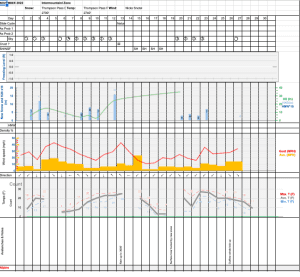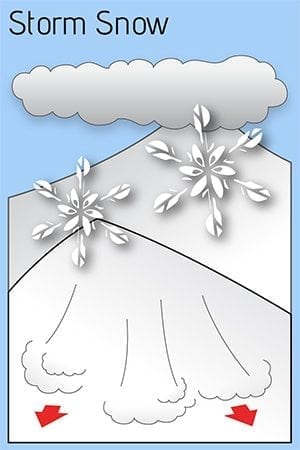Valdez
Above 3,000ftConsiderable
1,500 to 3,000ftConsiderable
Below 1,500ftConsiderable
Degrees of Avalanche Danger
Avalanche Problems
Problem 1
Another round of snowfall is forecasted to produce up to a foot of new snow near the coast with about half as much expected for Thompson Pass. Temperatures have been rising overnight and are expected to go above the freezing mark below 1000′ during the day for coastal locations. The amount of new snow we are expecting along with rising temperatures will temporarily elevate the avalanche hazard to considerable in the Maritime zone. Watch for signs of instability such as shooting cracks and collapsing that would indicate unstable snow at the surface. Hand shear tests and small test slopes are a quick easy way to test the sensitivity of new snow at the surface.
The intermountain and continental zones are not expecting enough snow to elevate the hazard in those areas. The hazard will remain moderate there unless more than the forecasted 4-8 inches of snow accumulates.
Wind slabs that were found to be reactive on 2/9 are expected to be gaining strength and the heavy snow load from last week has been observed in multiple locations to be well bonded with the snowpack except below 2500′ in the Maritime climate zone (see persistent slab problem below).
Faceting at the surface was not observed during the brief period of clear weather 2/9-10.
Likelihood:
- Almost Certain
- Very Likely
- Likely
- Possible
- Unlikely
Size:
- Historic
- Very Large
- Large
- Small
Trend
- Increasing
- Steady
- Decreasing
Problem 2
Up to a foot of new snow and increasing temperatures will put additional stress on a decomposing rain crust that exists below 2500′ that has recently showed signs of instability near the coast. The layer exists in all three forecast zones but has only been found to be a concern in the Maritime zone, this includes Keystone Canyon. This rain crust has lost strength since it has formed and has created a weak layer. It will be possible for the 1/25 rain crust to act as a failure plane in steep terrain at low elevations.
Watching for signs of instability such as shooting cracks and collapsing. Digging snowpits to asses stability in the area you choose to travel is a good idea if choosing to travel in steep terrain at low elevations.
Likelihood:
- Almost Certain
- Very Likely
- Likely
- Possible
- Unlikely
Size:
- Historic
- Very Large
- Large
- Small
Trend
- Increasing
- Steady
- Decreasing
Problem 3
Weak snow continues to exist near the base of our snowpack in all three climate zones. This weak snow has recently been under increasing pressure as heavy snowfall and strong winds occurred 2/5-7. The last recorded avalanche activity at this layer occurred during the 1/23-25 storm on Nicks Buttress / ~3500’/ north aspect (see avalanche activity section). The amount of snow and wind our area just received was significant, and was a great strength test of weak snow near the base of our snowpack. No avalanches have been observed that failed or stepped down to this layer during the latest storm. Human triggered avalanches are currently unlikely to occur that fail on weak snow near the base of our snowpack.
Faceted snow near the ground has been found to vary significantly from place to place. In most locations this snow has been found to be rounding (gaining strength) and unreactive in stability tests. In thin areas of the snowpack these facets are significantly more developed. The most likely places to affect weak snow near the ground will be in areas where the snowpack is thin.
If you find it is possible to push a ski pole to the ground in areas you travel. Assume that a weak faceted snowpack exists in that location, that could act as a trigger point.

Depth hoar from Nicks Buttress ~4000′ North aspect 1/31.
Likelihood:
- Almost Certain
- Very Likely
- Likely
- Possible
- Unlikely
Size:
- Historic
- Very Large
- Large
- Small
Trend
- Increasing
- Steady
- Decreasing
Avalanche Activity
Below is a summary of observed Avalanche activity from the last 7 days. Avalanches that were noted earlier in the season can be viewed by clicking the link below.
If you trigger or observe an avalanche consider leaving a public observation.
2/7- DOT avalanche control work on 2/7 produced several D2-2.5 avalanches. All of these appear to have failed at the new snow/old interface without any step downs observed. Avalanche activity mostly occurred in the mid elevation band 3500′-4000′ on the Buttresses of RFS, Cracked Ice, and Python. The most significant results occurred on Berlin Wall at ~5000′ with a crown that looks to exceed 2 meters. This was likely due to significant wind loading during the storm.
Very little natural avalanche activity was observed.
2/9- Several small (D1) natural avalanches were observed that failed on steep wind loaded terrain.
Weather
Check out our updated weather tab! A collection of local weather stations are available for viewing with graphs and tabular data included.
NWS Watches and warnings
NONE NWS Point forecast for Thompson Pass
Date Saturday 02/11/23 Sunday 02/12/23 Time (LT) 06 12 18 00 06 12 18 00 06 Cloud Cover OV OV OV OV OV OV OV OV OV Cloud Cover (%) 100 100 100 100 85 85 90 75 75 Temperature 19 24 26 20 19 21 22 15 13 Max/Min Temp 27 17 25 7 Wind Dir SE SE SE SE NE NE E E NE Wind (mph) 12 13 13 6 5 5 4 9 8 Wind Gust (mph) 28 33 25 27 Precip Prob (%) 100 100 100 90 70 70 70 30 5 Precip Type S S S S S S S S 12 Hour QPF 0.28 0.12 0.05 0.04 12 Hour Snow 3.8 1.6 0.7 0.2 Snow Level (kft) 0.5 1.0 0.8 0.3 0.1 0.0 0.0 0.0 0.0
Click on link below for Thompson Pass weather history graph:

| Date:
02/11 |
24 hr snow | HN24W* | High temp | Low temp | 72 hour SWE* | February snowfall | Seasonal snowfall | Snowpack Depth |
| Valdez | 6 | N/O | 29 | 20 | N/O | 37 | 182 | 64 |
| Thompson pass | ~4 | N/O | N/O | N/O | N/O | 56 | 345 | 64 |
| 46 mile | Trace | 0 | 16 | -13 | 0 | 13 | ~80** | 48 |
*HN24W- 24 hour Snow water equivalent in inches
*SWE– Snow water equivalent
**46 mile seasonal snowfall total begins December 1st.
Additional Information
Click on the link below for a running summary of the seasons weather history.
Announcements
The avalanche hazard is Considerable at all elevations for The Maritime climate zone. Up to a foot of new snow along with rising temperatures will make human triggered avalanches likely up to 1 foot in depth above 2500′. Below 2500′ human triggered avalanches could be deeper, 2-3 feet deep as a buried weak layer of snow exists at low elevations that has recently showed signs of instability. Watch for signs of instability such as shooting cracks, collapsing and recent avalanche activity.
Posted by Gareth Brown 02/11 8:00 am.
For a description of current avalanche problems, weather information, season history and more click the (+ full forecast) button. Avalanche forecasts will be issued Wednesday-Sunday.
If you have pictures of recent natural or human triggered avalanches or notice signs of instability such as shooting cracks or collapsing, leave an observation to help improve forecast accuracy.


